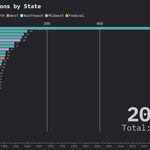DPI Report: The 2% Death Penalty
How a Minority of Counties Produce Most Death Cases at Enormous Costs to All
DPI Page: Ring v. Arizona
Supreme Court Declares Defendants Have a Right to Jury Determination of Eligibility for Death Sentence
Overview
The number of annual executions in the U.S. does not necessarily reflect the current public mood about the death penalty because executions typically occur fifteen or more years after a death sentence has been handed down. The number of executions is also affected by reversals on appeal and clemencies granted. Death sentences, on the other hand, are a timely measure of prosecutors’ decisions to seek death and juries’ unanimous votes to impose it.
However, it is also difficult to discern public sentiment on the death penalty from the number of death sentences. These sentences vary greatly among the states, even when measured on a per capita basis. Moreover, the sentences are often clustered in particular counties within a state. Counties with the highest number of murders do not always produce the most death sentences. Nevertheless, it is relevant that the national annual number of death sentences has declined by over 80 percent during the past 25 years.
At Issue
One might expect that the number of death sentences would be directly proportional to the number of murders committed in a jurisdiction, but that is not often the case. For example, the number of death sentences in the U.S. has plummeted since 2000 while the country’s murder rate has remained fairly stable. The local use of the death penalty is strongly affected by the views of the county’s district attorney, by racial factors, and by the financial resources available in particular jurisdictions.
What DPI Offers
Statistics are available on the number of death sentences by jurisdiction and year. Recent data include racial information on sentences. Death sentences can be easily compared to the murder rates for various jurisdictions and time periods.
For more information about state-by-state sentencing procedures, see DPI’s pages on Ring v. Arizona and Sentencing Alternatives.
News & Developments
News
Aug 27, 2025
Mid-Year Review 2025: New Death Sentences Remain Low Amidst Increase in Executions
This week we are featuring some articles from the first part of 2025 that we think are worth another look. We’ll be back with new articles next week. This article originally ran on July 7, 2025. At the midpoint of 2025, the Death Penalty Information Center (DPI) offers this detailed analysis of the key facts and themes emerging in the use of the death penalty across the U.S. For more than 30 years, DPI has been the preeminent national resource for timely and trustworthy…
Read MoreNews
Jul 07, 2025
Mid-Year Review 2025: New Death Sentences Remain Low Amidst Increase in Executions
At the midpoint of 2025, the Death Penalty Information Center (DPI) offers this detailed analysis of the key facts and themes emerging in the use of the death penalty across the U.S. For more than 30 years, DPI has been the preeminent national resource for timely and trustworthy information about the death penalty. Its careful tracking and analysis of death sentences, executions, legislation, and newsworthy events provides critical context to inform meaningful…
Read MoreNews
Sep 27, 2024
United States Reaches 1600 Executions, Demonstrating Disconnect Between Elected Officials and Declining Public Support
The United States has reached a milestone in the administration of capital punishment this week. All four scheduled executions in Texas, Missouri, Oklahoma, and Alabama took place, marking the 1600th execution in the modern era of the death penalty in the U.S., despite public opinion polls showing growing concerns about the fairness and accuracy of the death penalty and declining support…
Read MoreNews
Sep 13, 2023
When Jurors Do Not Agree, Should a Death Sentence Be Imposed?
Recent exonerees sentenced by non-unanimous juries (clockwise from top left): Ralph Wright (FL), Clemente Aguirre-Jarquin (FL), Anthony Ray Hinton (AL), Clifford Williams (FL), Isaiah McCoy…
Read MoreNews
Jul 26, 2023
NEW RESOURCES: Capital Punishment and the State of Criminal Justice 2023
The American Bar Association’s Criminal Justice Section has announced its forthcoming annual report, The State of Criminal Justice 2023, examining the state of the American…
Read More



